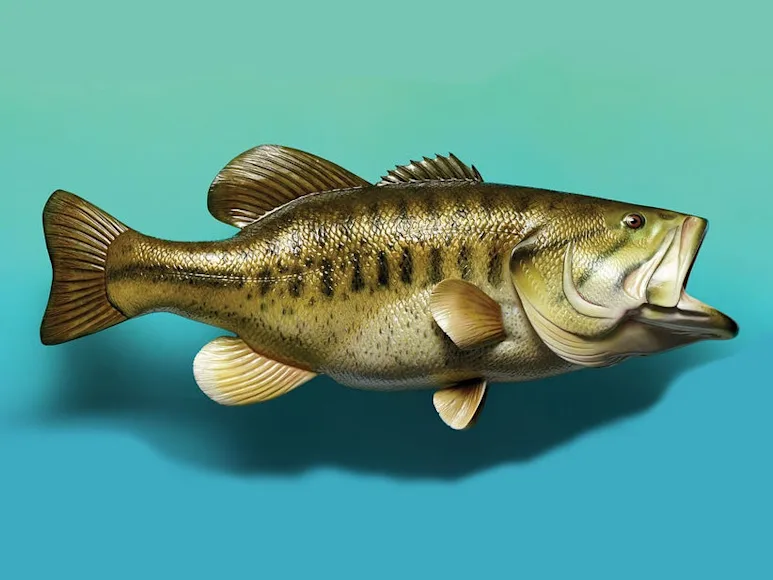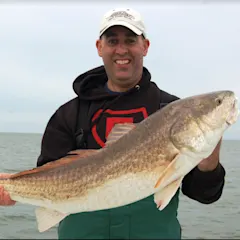Ten. Americans obsess over the number. We compile top 10 lists
; you need 10 yards to get a first down; and in 1979, Bo Derek starred in a movie about physical perfection with the appropriate title 10. Only the Spinal Tap guys worried about turning it up to 11, but we were all in on the joke: Nothing’s better than reaching 10.
When it comes to largemouth bass fishing
, that same number plays an outsize role. The bass is the most American gamefish of all, and a 10-pounder is the undisputed benchmark. “I’ve caught a lot of 7- to 9-pound bass, and you can usually get them on the patterns that catch 3- to 5-pound fish,” Texas bass pro Keith Combs told me. “But at 10 pounds, something changes.”
I talked with some of the greatest big-bass anglers in the U.S. about their best bass fishing tips and tricks, best lures for bass, and favorite locations for catching 10-pound bass. Depending on where you live, a 10-pounder may not be an option—but don’t let that stop you from reading, because these largemouth bass fishing tips will still help you catch the biggest bass of your life.
4 Trophy Tactics: How to Catch Big Largemouth Bass
Whether you catch a flight to chase your 10, or just want to connect with the biggest bass in your local pond, these five bass fishing techniques are your best bet in spring and summer.
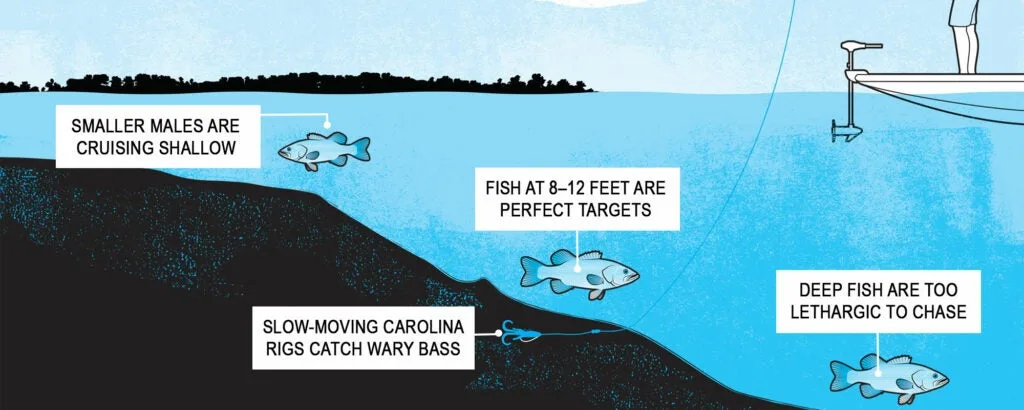
The key to this bass fishing technique is to fish the right depth. Illustration: Chris Philpot
1) How to Catch Bigger Bass with a Carolina Rig
Guide Clark Reehm says that on every east Texas trophy factory, the smaller males go up and cruise the shallows during the prespawn, but big females typically hold back and stage where they’re prime pickings for a Carolina rig
. This rig can cover water quickly while still presenting a natural profile. The key is targeting the right depth.
Big girls holding in wintertime haunts 20 feet down or deeper are often lethargic, and although they may eventually slide into ankle-deep water to lay their eggs, your best bet for prespawn sows willing to feed is in midrange depths of 8 to 12 feet.
Bass eggs adhere to hard surfaces, whether that’s rock or wood. With that in mind, Reehm works secondary points made of clay. “We don’t have a lot of rock in east Texas,” he says. “So clay is our hard-bottom substance.” With a decent graph, you can pinpoint the hard bottom and target that exclusively.
Where many might use a lizard imitation at the end of the rig, Reehm prefers a watermelon Zoom Brush Hog because it provides more bulk for fish that want the most bang for their bite.
You’ll want to cover water, but resist the urge to take your retrieve into overdrive. “The slower the better, because these fish aren’t there to feed,” Reehm says. “They’re waiting for some catalyst, like an increase in sunlight, to move up shallow to spawn.”
2) Why a Giant Swimbait Is One of the Best Lures for Bass
Mike Bucca of Georgia makes the double-jointed Bull Shad Swimbait in tournament sizes of 5 and 6 inches, but he also makes a 9-inch brush-tailed beast that imitates the local prey perfectly. Cashing in with one means striking at the right time of day in the right kind of water.
Bucca says a major benefit to chucking giant swimbaits is that they expand the strike zone, meaning the fish can see and hear them from a long distance, which makes it less important that you cast to a pinpoint location.
If he had to choose one particular time to look for big mama, it would be right when the water hits 50 degrees in spring, Bucca says. “The biggest fish in the lake almost always spawn first, so they move up early to feed and get ready. It happens a lot earlier than people think.”
Many hard-bodied swimbaits have multiple treble hooks, but you can’t hesitate to throw them in the thick stuff. “I concentrate on docks and laydowns at the mouths of spawning flats in spring,” Bucca says. Just be sure to carry a lure retriever.
3) How to Hunt Big Bass with a Crankbait
Crankbaits that hit the bottom in 20 feet of water have flooded the market. “Strike King’s 10XD is the bait that I have most confidence in when I’m hunting big fish,” says bass pro Keith Combs. Putting a lure like that to work, however, means rethinking how you crank.
A big crank requires a big stick. Combs likes a stout 7-foot 10-inch cranking rod from Power Tackle, but to keep the wobble up, he uses a sensitive, small-diameter 15-pound fluorocarbon.
It doesn’t matter whether it’s in Texas or a TVA reservoir; during summer your best bet for cranking up a double-digit bass is to work long points or bars on or near the main lake.
Don’t assume that a deep-diving crank is only good in deep water. Combs will throw his over a shallow point or bar and work it into the depths. “Even in 8 to 15 feet of water, a 10XD will run right.”
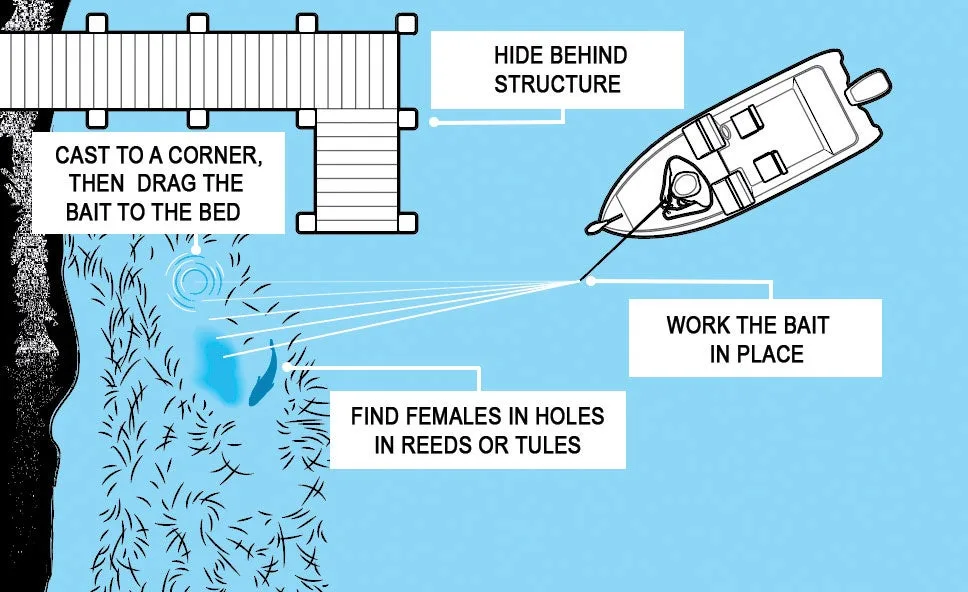
Bass pro Ish Monroe likes to soak a soft plastic in a bed, barely twitching it in place, until the big largemouth is agitated into striking. Illustration: Chris Philpot
4) How to Sight-Fish for Trophy Bass
Some anglers may be intimidated by the idea of sight fishing for the bass of a lifetime. After all, if you can see her, she can see you. But for bass pro Ish Monroe, if he’s on a lake with adequate visibility and the spawn is on, it’s his favorite way to chase them. “The lake has to have gravel and a lot of big fish,” he says. “You also don’t want the water to be super clear.” Success is all about how you approach, and how well you can overcome your jitters.
Monroe doesn’t target fish that have a 360-degree view of approaching predators. “Ideally they’ll be in a pocket of reeds or tules or next to a dock to give you some ability to sneak up on them,” he says. Use that cover to your advantage by moving in close enough to see which way the female is facing, and then readjusting your angle.
If you get too excited and pull a bait off the bed when the fish approaches, it will get the message that the bait is no threat. Monroe prefers to soak a soft plastic in a bed, barely twitching it in place, until the big girl is agitated into striking.
A lure that undulates in place allows you to milk a cast and push the agitation needle to 10. Monroe’s go-to is a Missile Baits D Stroyer creature bait, which he says has a better hookup ratio than tubes when rigged Texas style.
Baiting Game: 10 of the Best Lures for Largemouth Bass
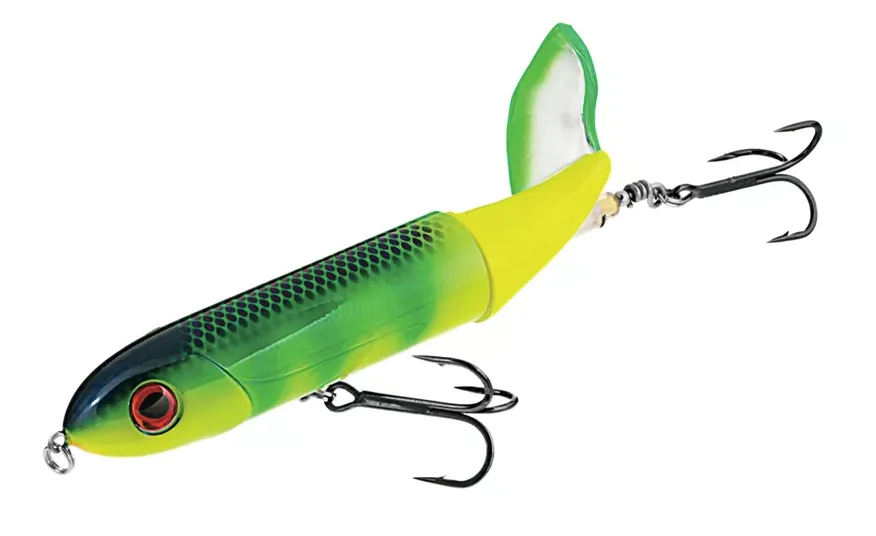
The River2Sea Whopper Plopper is a favorite topwater lure among bass pros. Cabela’s
Largemouth bass this big don’t like to chase a meal and are not easy to fool. So when they do make a move, they want a lot of calories and protein for the effort. If you were to devote a tackle bag to lures for double digits only, it would have to include these 10 baits.
1) Soft Swimbait
The Basstrix Paddletail made popular on Clear Lake in California in 2007 became the inspiration for a thousand copies. This style of lure still fools giants, and with ultra-fluid motion and no sound, it can tempt wary fish at any depth. Today, newer in-line and line-through models from several companies are available in sizes from 3 inches up to a foot. Bass pro Jared Lintner says his favorite is the 7-inch in-line Magnum from Top Shelf Tackle, and if a double-digit were his goal, he’d fish this lure from dawn to dark.
2) Glide Bait
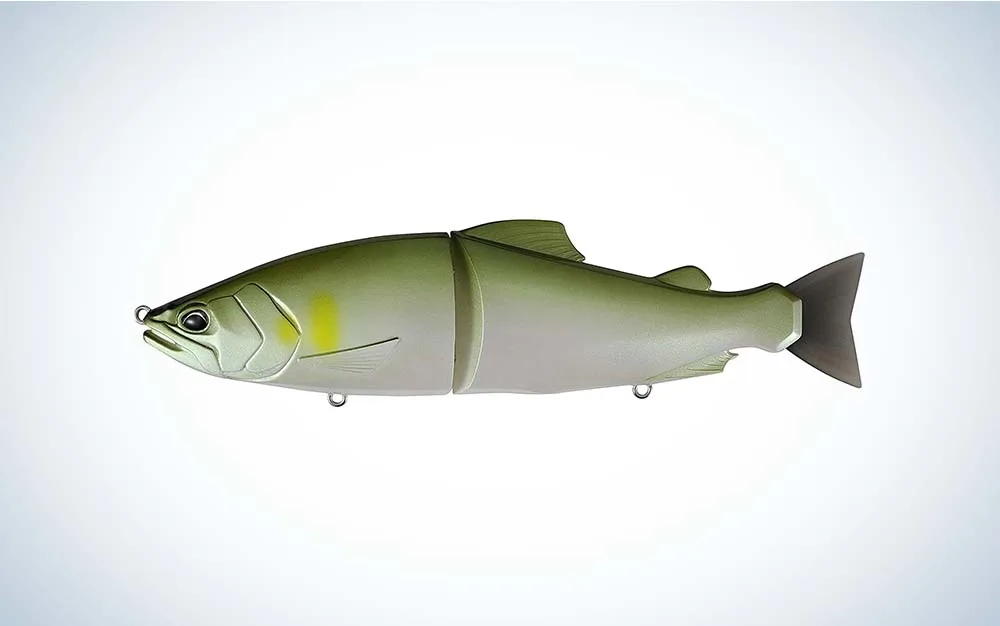
These single-jointed hard lures are noted for their distinct S-motion swimming action, and in the hands of a big-bait artiste they can be made to turn 180 degrees to challenge a noncommittal follower. Japanese imports can fetch up to $400, but baits like the Duo Realis Onimasu
work just as well for about $50. In clear water, glide baits are the ultimate fish finders, and just when you think a bass is only a follower, it will get that bait crosswise in its maw.
3) Carolina Rig
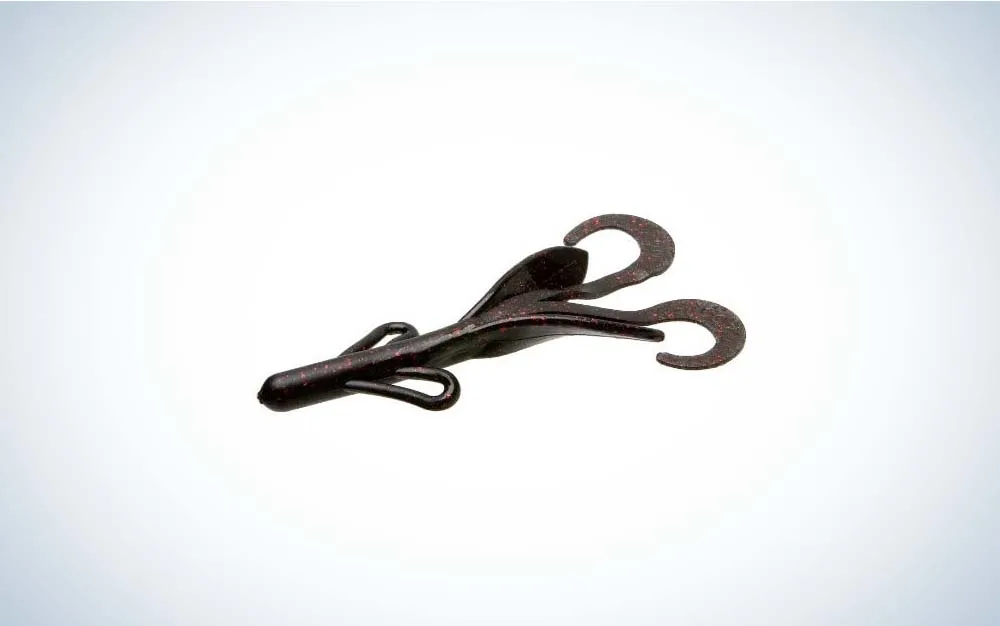
A Carolina rig lets you cover water with a bulky plastic that replicates a crawdad, lizard, or shad fairly quickly but with a subtle presentation. It is equally deadly on outside grasslines in spring, and on offshore structure during the heat of summer. You can fish them shallow or deep, and in heavy current, simply by adjusting the weight. Lots of plastics score, but the original Zoom Brush Hog
has always been a top big-bass producer.
4) Jig and Trailer
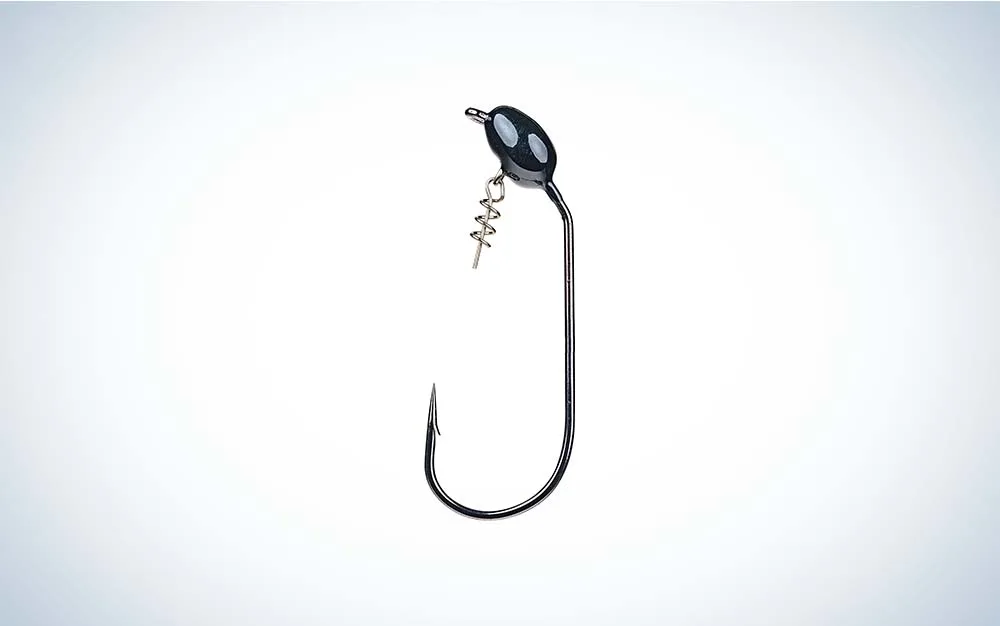
With so many new lures available, you wouldn’t think a skirted hunk of lead would be so deadly. But simplicity still works just as it did decades ago—and jigs like Strike King’s Tour Grade
now come with better components than ever before. The color, weight, and fall rate can be adjusted with a change of trailer, but more important, a jig is always fishing. Even at rest, the skirt flares with the current, continuing to taunt big mama.
5) Oversize Crankbait
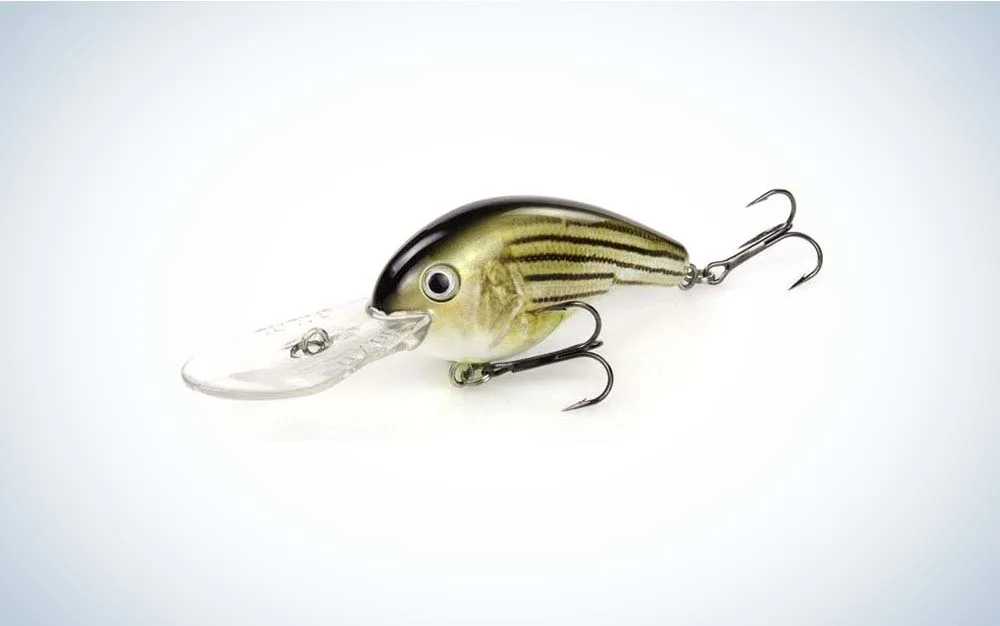
The Strike King 10XD
gets the most credit for bringing the mega-crank trend to the public, but it’s not the only lure of its kind. Many companies produce models that pass the 20-foot diving mark, a depth that was not within the range of a normal cast with normal tackle just a few years ago. These cranks will get in front of the deepest bass, and with the introduction of big shallow-running squarebill models, they can also bust giants in skinnier water.
6) Craws and Creature Baits
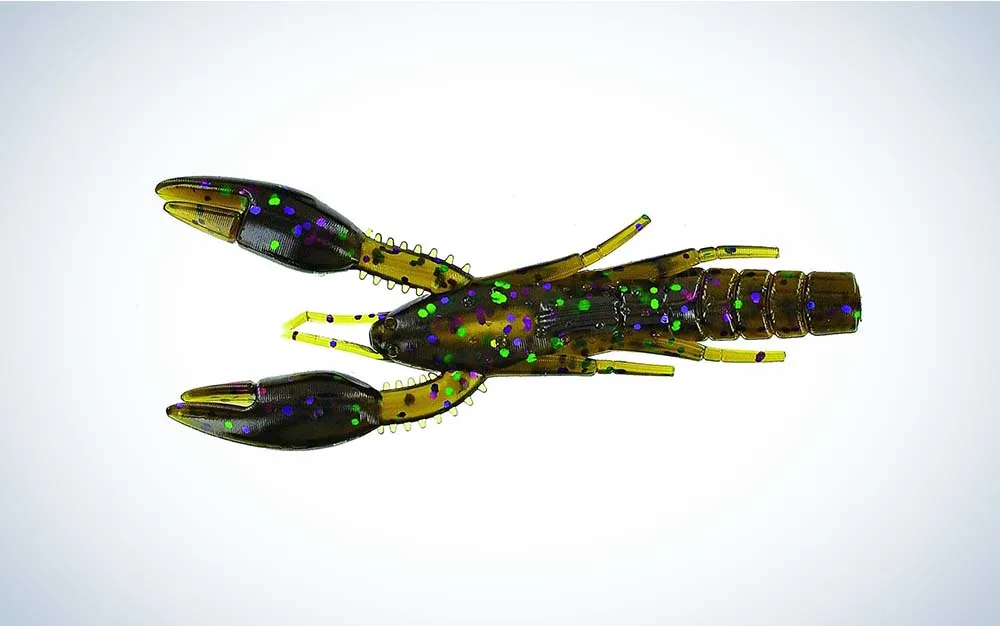
When it comes to flipping in tight cover, sometimes it pays to pair a big tungsten weight with a bite-size lure. In Florida, anglers utilize stubby little craws like the Yamamoto PsychoDad
, and throughout the country, 3- to 4-inch gliding soft plastics like the Sweet Beaver work year-round. It’s not that the fish don’t want a bigger meal, but rather that these compact lures can penetrate thick grass or laydowns better than a gangly lizard or a ribbon-tailed worm.
7) Big Topwater
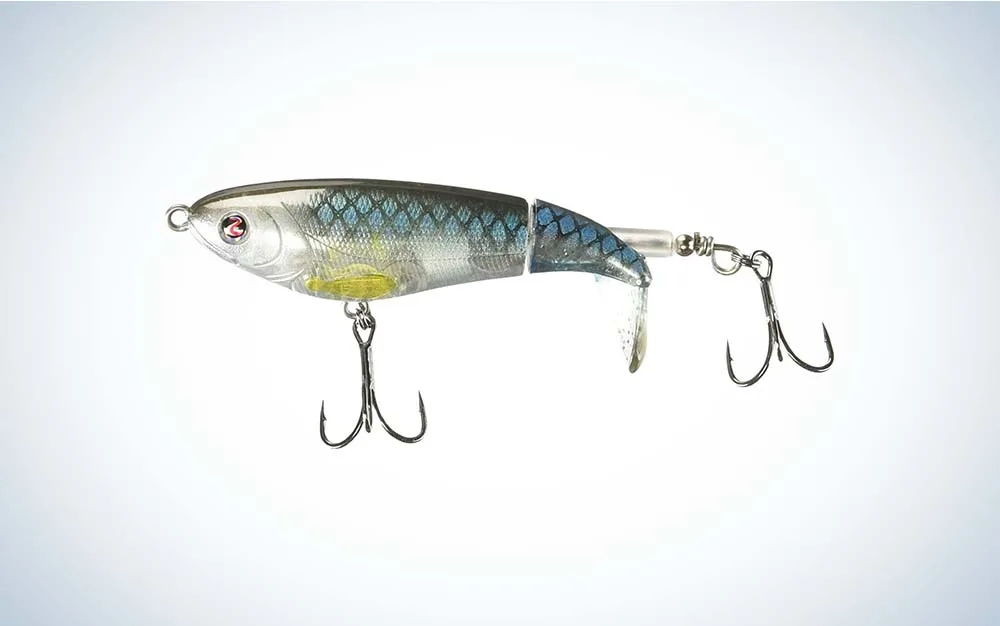
Giant Spook-style baits like Black Dog’s Lunker Punker call up monsters, but the latest phenomenon to hit the bass scene is River2Sea’s Whopper Plopper
. Borrowed from the muskie world, it marries a stationary front section to a rotating, single-finned tail that kicks up a fuss. Retrieve it steadily or rip it; spring through fall you’ll be in position to tempt a reaction strike from the meanest big bass on any lake. If you’ve neglected to take your heart medication, go subsurface.
8) Umbrella Rig
Umbrella rigs—a.k.a. Alabama rigs—like those from Hog Farmer Baits may look like chandeliers out of the water, but retrieved subsurface they perfectly match a school of shad. Most of the lures on this list are best in spring and summer; this is one of the few that tempts suspended lethargic bass during the worst coldwater periods. And if you think one 10-pounder on the line will be a struggle, wait until you have two pulling against you (check local regs).
9) Giant Worm
Plastic worms may be the most basic and universal of all bass lures, and there’s a reason for that. Worms can be fished at any depth, in any water color, and with advances in hook, line, and sinker technology, they’re deadlier than ever. California anglers lean on triple-laminate straight tails, often measuring up to 18 inches. In Mexico, 10-inch Power Worms
are the gold standard. On the TVA lakes, don’t be caught without a plum-colored Zoom Ol’ Monster.
10) Yamamoto Senko
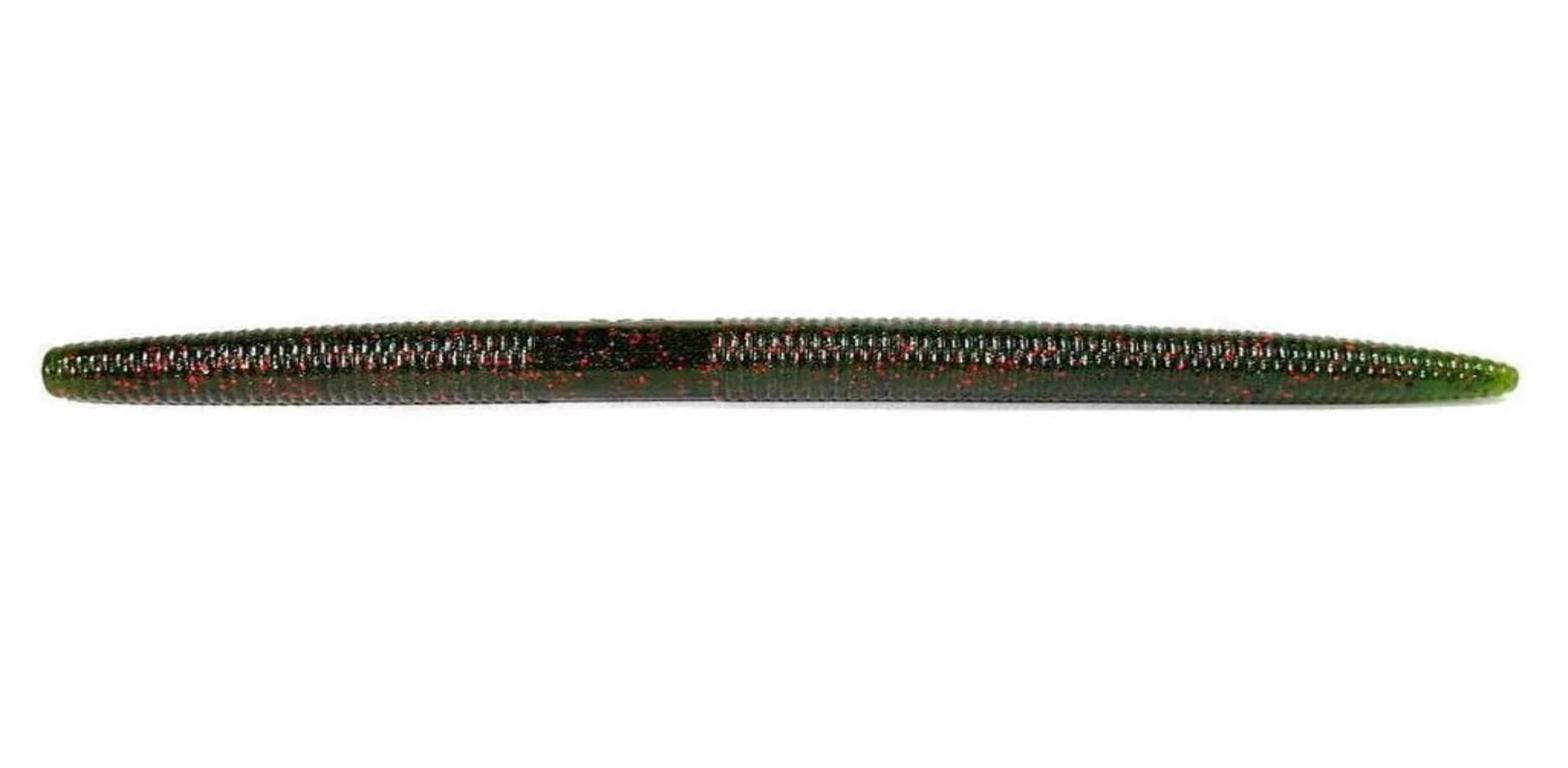
This oversize replica of a Bic pen might be the most unlikely success story in the history of bass fishing, but despite its do-nothing look, it has likely caught more bass than the next two most productive baits on this roster combined. Fished Texas style or wacky style, it has a slow, seductive shimmy on the fall that dozens have tried to copy (unsuccessfully for the most part). When hunting lunkers, step up to the 7-inch model, which has a lot more girth than the 6-inch Senko
.
Hotspots: How to Catch Big Bass in Ponds and Lakes
Not everyone lives close to 10-pounder waters, but that doesn’t mean you can’t use the recipe for double-digit heaven to figure out which local lake will give you your optimum shot at a personal best.
Genetics: Florida-strain bass usually grow bigger than their northern-strain counterparts, so if you’ve got Florida strains locally, you’re already ahead of the game.
Forage: Bass that expend lots of energy for low levels of nutrients can’t reach their peak size and performance. This is why so many big-bass factories are associated with specific prey like tilapia and gizzard shad.
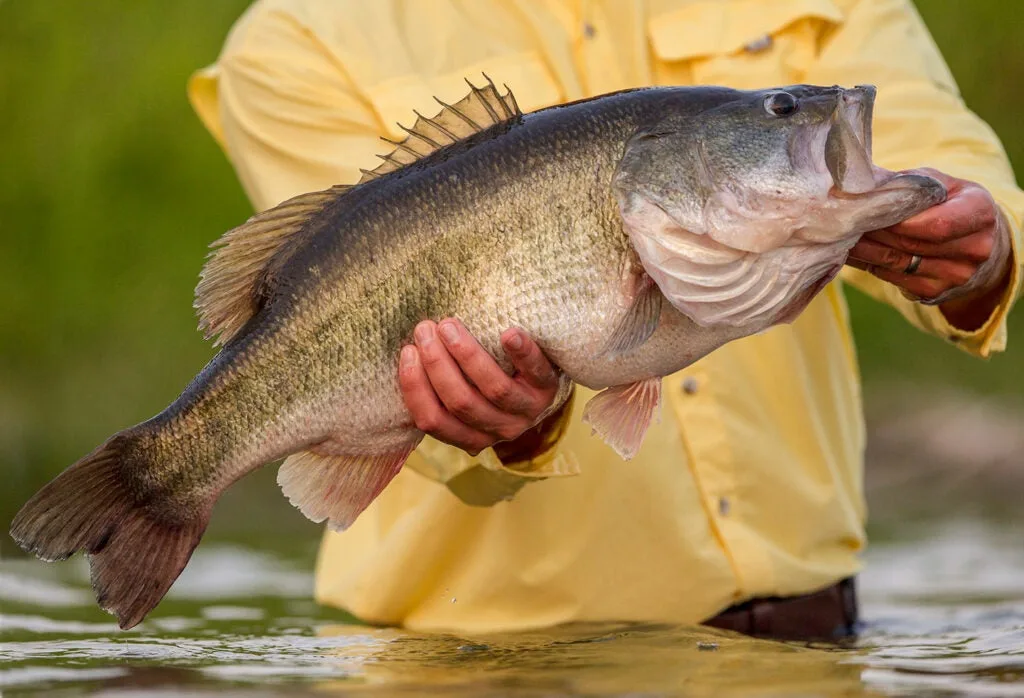
This bass fisherman is in hawg heaven. Lance Krueger
Hiding Spots: Even genetically superior bass fry can’t survive if they aren’t protected from predators, and likewise their forage also needs that safety net. That’s why so many top lakes have thick, impenetrable grassbeds or fields of thick timber that prevent entry by any boat.
Water Quality: Plenty of great trophy fisheries have sewage discharges and industrial development along them, but when you see the vegetation start to die off, or the baitfish start to dissipate, or the fish of any size start to look unhealthy, you may need to look elsewhere.
Growing Season: Not only do the warm temperatures of Mexico, Texas, and Florida provide comfort to the notoriously cold-averse Florida-strain bass, but they also keep the fish active year-round. They may go offshore during summer in search of structure-oriented current, but they continue to feed. Furthermore, it spreads out the spawn, giving a year class more chances to succeed.

Falcon Lake on the Texas–Mexico border is a genuine trophy factory. Lance Krueger
The 10 Best Places in the World to Catch Largemouth Bass
1) Lake Fork, Texas
If you built a trophy reservoir straight out of the textbook, you’d get Lake Fork. It has everything needed to continually pump out big Texas bass: standing timber, vegetation, creek channels abutted by big spawning flats, and prolific baitfish like shad and the calorie-rich barfish. Fork gave up the Texas record—an 18.18-pound brute caught in 1992—as well as Texas’s top six bass, and 12 of the state’s top 15.
2) Toledo Bend, Texas & Louisiana
The Toledo Bend Lake Association awards a free fiberglass replica to anyone weighing in a bass over 10 pounds in its Lunker Bass Program, and in 2015, the annual record was broken for the fourth straight year with 139 qualifying largemouths—including a 14.16-pound monster. This giant border reservoir can be difficult for the newcomer to navigate with its massive amounts of brush and timber. But the lake is also chock-full of hydrilla—and all of that cover provides endless hiding places for hawgs.
3) Lake Okeechobee, Florida
Okeechobee has had its ups and downs, often correlating to water levels, but it has such a healthy stock of fish and an extended growing season that it never takes long to bounce back. Right now it’s on the upswing and loaded with hydrilla, eelgrass, and peppergrass. Big fish can spawn from November through March. Many of the largest bass are caught on live shiners, but artificial lures produce as well. Sight fishing is excellent, but punching the lake’s thick mats produces giants, too.
4) Clear Lake, California
While many northern California lakes are touted as big-bass meccas, Clear Lake continues to be the best. This is where Steve Kennedy convinced the entire country that swimbaits are a viable tournament tool when he won an Elite Series event in 2007, and since then the lake has continued to pump out 30- and 40-pound tourney limits and lots of double-digit fish for trophy hunters. One way to catch a 10 is to use swimbaits meant to match the Clear Lake hitch, a local baitfish. But with grass-lined shores and deep rockpiles, there’s no shortage of ways to target them throughout the changing seasons.
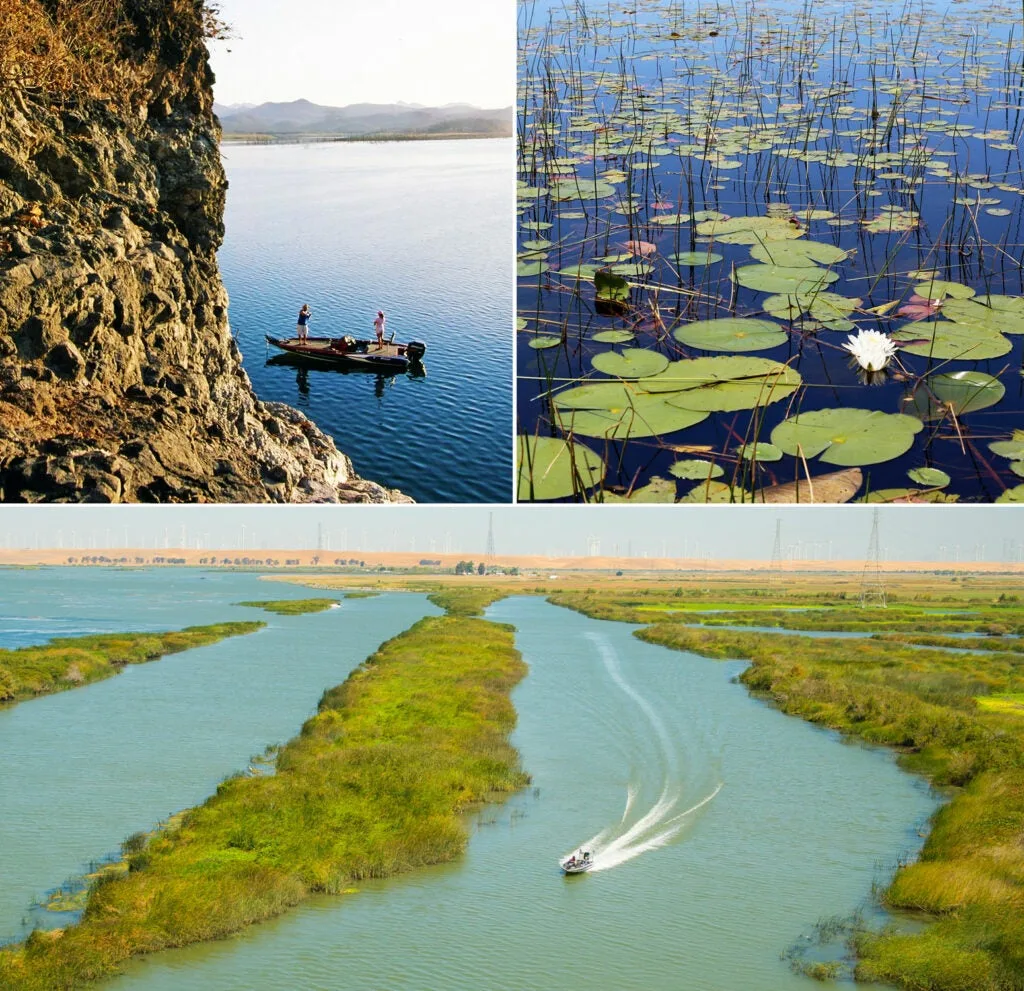
Clockwise from top left: Lake El Salto, Lake Okeechobee, and the San Joaquin Delta. Clockwise from top: Keith Sutton; Age Fotostock/Alamy; Brian Grossenbacher
5) San Joaquin Delta, California
Heavy vegetation, hundreds of miles of sloughs, canals, and small lakes, and Florida-strain bass combine to make this fishery consistently excellent for both size and numbers. It’s possible to catch bass in a variety of ways here, from flipping to finesse techniques to throwing big swimbaits, all while having a decent-size area to yourself. “Over the past five years, in seemingly every tournament, whether it’s five boats or 150 boats, there have been multiple fish over 10,” says bass pro Jared Lintner.
6) Pickwick Lake, Alabama, Mississippi & Tennessee
Guntersville and Kentucky Lakes get much of the press, and rightfully so because they continue to produce huge numbers of 5- to 8-pound bass. Among the TVA reservoirs right now, however, Pickwick is the champ for double digits thanks to a major grass resurgence. In 2012, Lance Walker caught a potential lake record that appeared to weigh somewhere in the 15-pound class, but he released it without taking it to a certified scale. Chickamauga, another TVA impoundment, has also produced ten-ers, and the common denominators are lush fields of underwater grass and slightly less fishing pressure than neighboring waters—at least for now.
7) Lake Berryessa, California
Bass pro Ish Monroe says that in California there are “about 15 sleeper lakes,” but about Lake Berryessa he adds, “I’d bet everything I own that it holds a world-record spot, largemouth, and smallmouth.” Berryessa isn’t far from Sacramento but has minimal development, so it remains unpressured. It also has deep water and a fertile population of forage, and in the last decade it has received an influx of hydrilla.
8) Falcon Lake, Texas & Mexico
Falcon Lake is hardly a secret spot. After all, it produced the record B.A.S.S. four-day total of over 130 pounds for 20 fish, a 61⁄2-pound average, back in 2008. Unfortunately, despite the lake’s remote location (50 miles to the nearest Walmart), the pressure became extreme, and that combined with very low water meant the fishery suffered. Now it seems to be back, with huge numbers of 4- to 8-pound bass and a healthy population in the double digits, grown big on tilapia and living among the thorny mesquite and huisache bushes.
9) Lake El Salto, Mexico
Kevin VanDam called El Salto the ultimate bucket-list destination for bass anglers and for good reason: It’s where he caught his personal best five-fish limit weighing just over 50 pounds. There are certainly other good waters in Mexico—Comedero, Baccarac, Picachos—but none has remained so good for three decades as El Salto has. It’s full of heavily managed tilapia that supply protein-packed meals for the fast-growing bass, and the lake’s annual fluctuations of 30 to 40 feet provide a constant source of new cover and life.
10) Lake Letsibogo, Botswana
If you’re a true adventure junkie, southern Africa is where it’s at for big bass. Northern-strain fish were introduced here almost a century ago, but the fisheries in several countries exploded when Florida-strain fish were brought over more recently, with double-digit and teen-class fish becoming more common. You may have to contend with crocs and hippos—and inferior facilities—but bass pro Gerry Jooste says it’s worth such trouble to fish Lake Letsibogo, where bass gain weight during a long growing season on a diet of silver labeo, a baitfish that can grow up to 2 pounds.
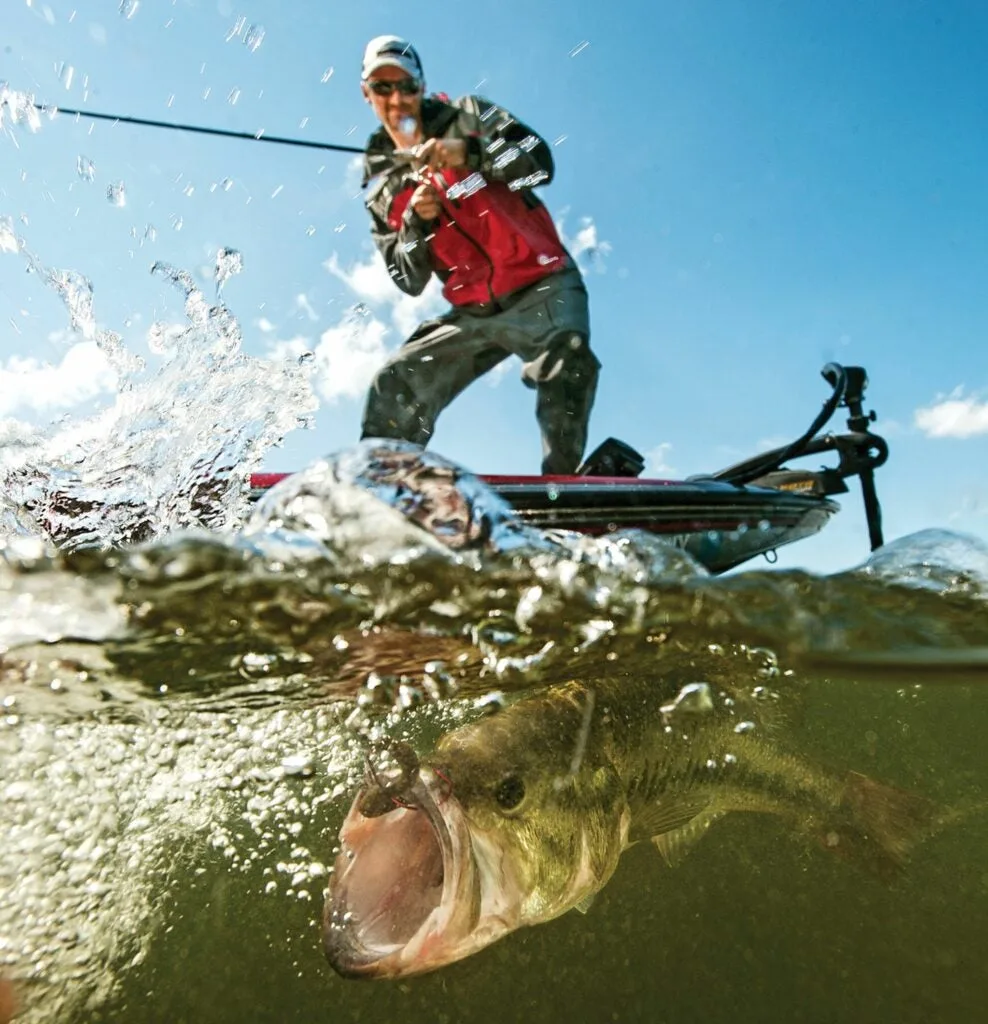
Huge bass are often lost because of simple angler mistakes. Our pro tips will ensure you never make any of them again. Bill Lindner
Bass Fishing Tips That’ll Keep You From Losing Another Big Fish Again
We bet you know the heartache of dropping a huge bass. Truth is, it’s often your own fault. From proper prep work to fight techniques to end-game insurance, these tips from a pro will keep you from feeling that sting ever again.
1. Check the Strength of Your Knot
The Problem: “I’ve heard so many guys say, ‘I’m using braid. I don’t have to check it or retie,’” Wolak says. “But I don’t care what line you’re using. You can’t make 500 casts without ever retying your lure. It doesn’t take much to weaken your line just a little, yet many anglers don’t want to be bothered retying, especially if the action is good. Then when a big fish hits, that one little nick hurts.”
The Solution: Run the 2-Foot Slide”Every single time I retrieve a lure, I’ll quickly slide my fingers down the first 2 feet of line before I recast. Do this until it becomes second nature. You won’t even think about it; you just sort of work the motion right into your cast. If I feel anything I don’t like, no matter how slight, I retie right away. I’m such a freak about retying that there are always surgical scissors in my back pocket.”
2. Don’t Set the Hook so Hard
The Problem: “Bass guys love to swing hard when they set, and when you’re used to hitting 2-pound squirts all the time, you can get away with it. Big fish are different. When you swing on a true trophy bass, very often it doesn’t move. It just feels like you’re setting against a rock, and snap goes the line. Because of that, many anglers lose big fish before they even knew they had them.”
The Solution: Slip Some Drag”If you’re fishing where you know there’s a chance of tying into a big bass, your drag has to be set properly ahead of time. If you pull it by hand and nothing pays out, it’s too tight. When you hook a big fish, you want the drag to slip just a little. This acts like a buffer between your own strength and fish that may not budge.”
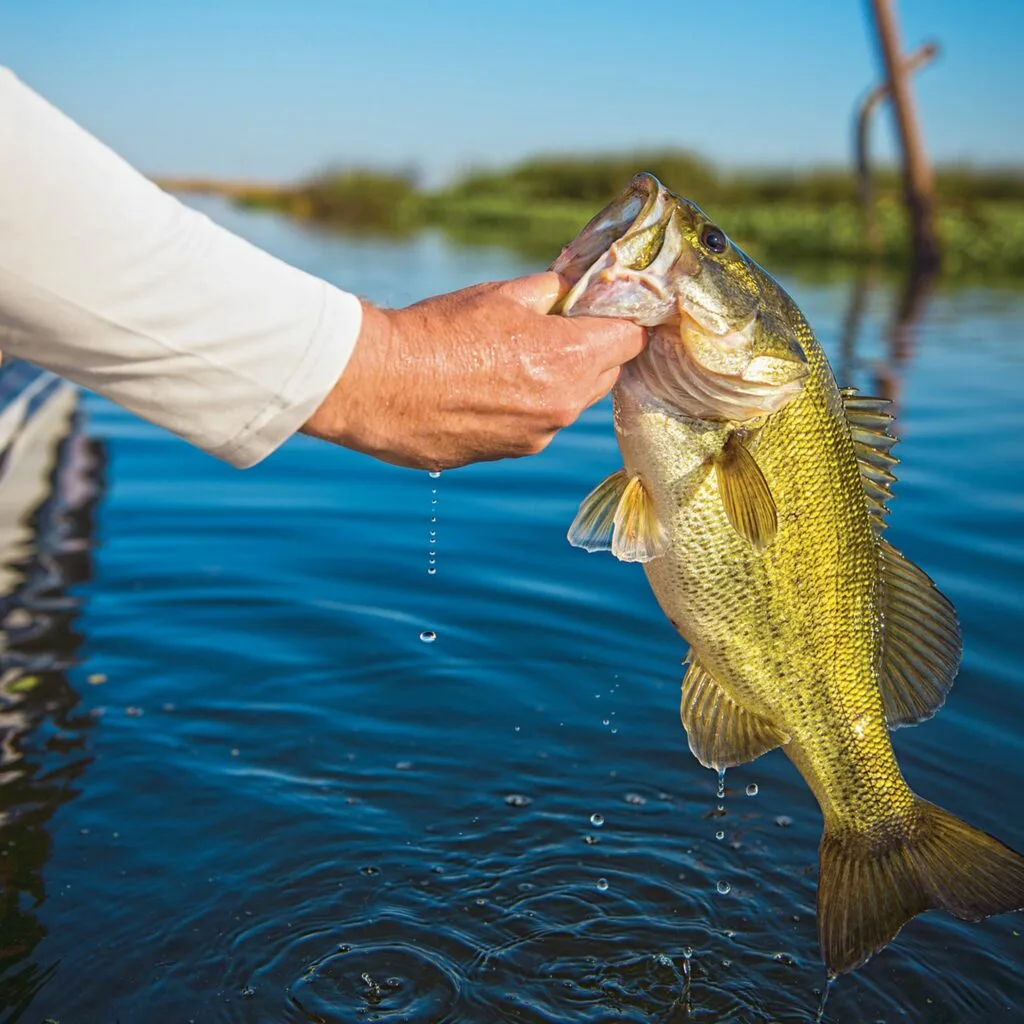
“Bass guys love to swing hard when they set,” says Wolack. Don’t be that guy. Brian Grossenbacher
3. Keep Your Cool During the Fight
The Problem: “An angler can be in total control of a big fish the entire fight
, and then he finally sees it next to the boat and loses all composure. Suddenly he thinks because it’s big, he’s going to lose it, so he grabs the line and tries to lift it into the boat fast. Or guys play the fish too long because they’re nervous, that hole in its mouth gets wider, and with one jump the bass is gone.”
The Solution: Block the Jump Shot”You don’t want a big bass to jump next to the boat. I keep my rod tip submerged 10 to 12 inches when the fish is close. That keeps its head down and helps stop it from jumping. If I see the line rising, I’ll bury the rod even deeper to keep that head down. I’ll wait to make the grab when the bass is calm and rolls over on its side, or even better, wait for it to be moving toward me with its mouth wide open.”
Victory: What It’s Like to Catch a 10-Pound Largemouth Bass
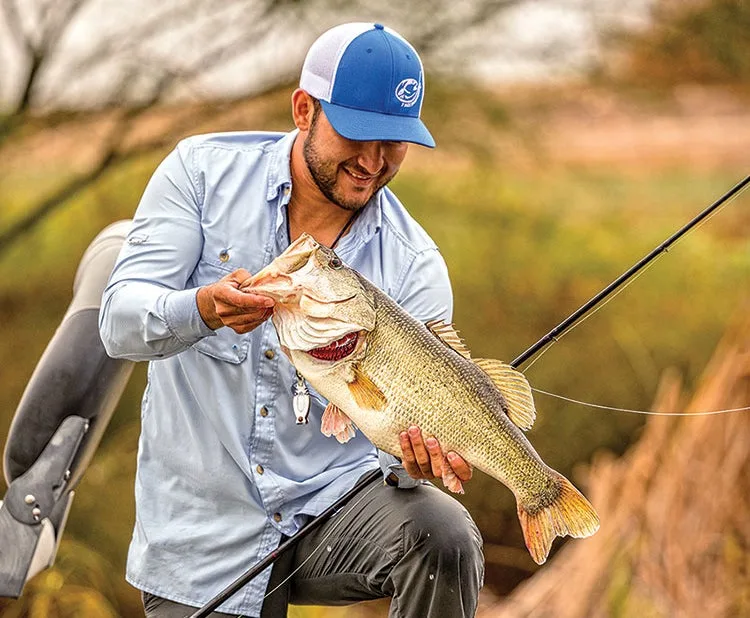
A happy angler grips his hawg. Lance Krueger
“Back in 2007, we were long-lining crankbaits and pulled up on a hump where I’d already caught 15 fish over 8 pounds that year. My customer sticks a fish and it weighs 10.09 pounds. After high fives all around, we release her and go back over the hump the other way. He sticks a fish and says it’s big. I tell him to get her up because there are trees down there, and he says, ‘I can’t.’ When we first saw it, I thought it was a giant carp. When we realized it was a bass, our jaws hit the boat. That fish weighed 13.5 pounds when we got it certified for the Texas ShareLunker program. In 2013 it happened again. Right after boating a 10, we caught a 13 on the next pass at a different hump. Every time we hook a fish like that, I’m shaking as much as the client. Ten-pounders are rare, but for every 60 or 70 fish that size, you probably catch one 13. The older I get the more special it becomes because I know the odds are against me.” —Lance Vick, Lake Fork guide
Heartbreak: What It’s Like to Lose a 10-Pound Largemouth Bass
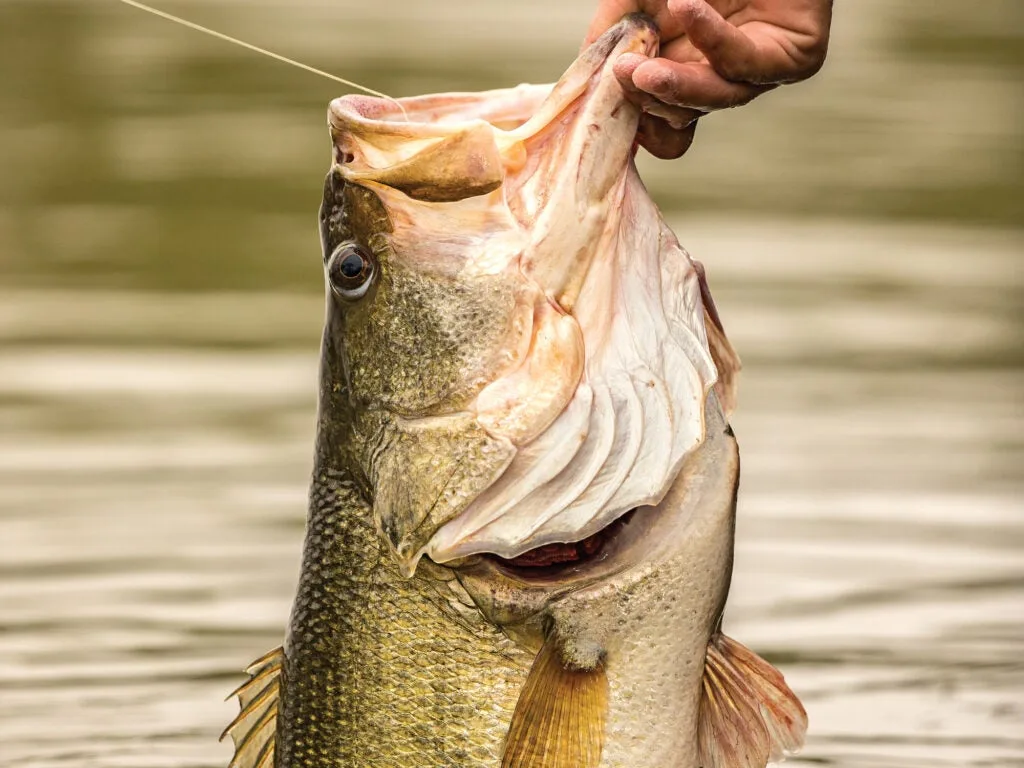
Imagine a bass this big breaking off… Lance Krueger
“Grandma is a true giant who lives around an old abandoned dock in a narrow cove on a public Georgia lake. She’s tortured me since 2014. On our first encounter, I hooked her with a 9-inch Bull Shad and lost her at the boat. During that battle she lost a chunk of skin off the top of her head, leaving a very distinct white mark. I have seen this fish at least 50 times since, so now she is educated. Last year I walked the woods in full camo to get a different casting angle. I even designed a new bait just for her. On the second cast, she nailed it. Unfortunately, I wasn’t in a boat where I could control her, and she wrapped me around the lead dock piling and broke me off. Another heartbreak! Guess what my 2017 New Year’s resolution is?” —Mike Bucca, inventor of Bull Shad Swimbaits

